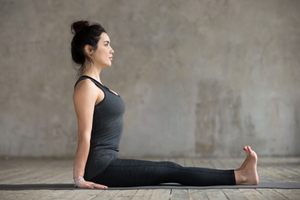Deadlifts of various types can help with total-body fitness. Compound movements, like the deadlift, burn more calories, strengthen the core, and improve posture, balance, and overall athletic performance.
But how to know which deadlift to do? We’ll break down two of the most important lifts, and what each does for you. We’ll also give you the dangers to look out for, to avoid injury and keep you working out longer and more effectively.
Standard Deadlift
Performed properly, the Standard Deadlift begins with the bar on the ground, with the bar an inch or two from the shins. You should have your feet roughly shoulder width apart, and your hands at a comfortable width outside of your legs. Lower your body at the knees first, and then the hips, until you can grasp the bar.
Tip:
Keep your spine slightly bowed as in the picture above, with your chest pointed toward the wall in front of you, and your shoulders back!
Once you have the bar grasped firmly, take a deep inhale. On the exhalation, push through your heels, keeping your chest up and your chin level with the ground. Keeping your chin level helps keep your spine in line, as anyone in yoga will tell you. Once your chin or head dips, you’re throwing your spine out of alignment, and could roll your back into a hump.

Tip:
As you become more comfortable with the lift, start focusing on keeping your abdominal muscles tight throughout the rep, like one long sustained crunch. Over time, this will strengthen your lower back, too.

Continue pushing through your heels, and as your knees begin to straighten, flex your erector spinae to straighten your back (standing you up straight).
Tip:
Do not lock your knees when you complete your lift! This is a common mistake that takes the full weight off your muscles and places it on your ligaments and tendons–which can lead to injury.
To lower the bar and complete the rep, take a deep inhalation while you bend your knees in a controlled descent, while bending at the hips. Remember, keep your chest facing out and your chin up. Once the bar is safely on the ground, release your grip and stand exactly as you did with the bar, lifting your weight with your knees and keeping your back straight.
Tip:
If you find that your lower back or knees can’t quite handle picking the weight up from the floor, or setting it down that low, use blocks or a weight rack! You’ll still get an amazing workout by starting with the bar even a foot off of the ground, and it’s not worth injuring yourself to go all the way to the ground.
Common Mistakes
Here’s a great video of the standard deadlift, with a barbell.
Romanian Deadlift
The Romanian Deadlift is a slightly different beast than the standard deadlift, and it has its proponents. However, because of the nature of the muscles worked, there is a higher risk of injury if performed improperly.

The primary muscles used in the Romanian Deadlift, or RDL, are the hamstrings, the rhomboid muscle group, the glutes, and the erector spinae.
The RDL begins from the standing position. Foot and hand widths are similar to the standard deadlift. You can take the bar off of a squat rack with the pegs set at hip-height, or use dumbbells.
In either case, once the weight is in hand, set your torso by straightening your spine, pushing your shoulders back, and engaging your core muscles. Before you lower the bar into the rep, make sure your knees are unlocked–they should have a very slight bend in them, so as the weight descends, it is taken on by your hamstrings, and not your spine.


Tip:
In yoga, some teach to imagine pushing your tailbone down and your skull up, literally lengthening your spine in the process. By doing this while engaging your core muscles, you align your spine for a proper and safe RDL.
Next, inhale as you lower the weight by hinging your body at the hips keeping your spine straight and your chest forward. This portion of the lift represents the greatest risk of injury, including slipping a spinal disc out of alignment. Allow the bar or dumbbells to lower just past your knees. Do not let the weight hit the ground!
You should be at the end of your inhalation at this point, so exhale as you stand up, again hinging at the hips with your knees almost straight, your chest out, and your head up.
Tip:
Push through your heels during the lifting portion of the RDL. This helps keep your whole body in alignment as you work.

At the top of the rep, keep your knees slightly bent, and finish your exhalation. At this point you can re-rack your weight, or perform another rep.
Here’s a great video on how to perform the RDL with dumbbells.
Main Differences
The main differences between the two lifts are that the Standard is a straight power lift, designed as a building block for the traditional power clean, the squat, and a number of other exercises. The RDL, on the other hand, is a complex, nuanced lift in its own right, that should be undertaken with extreme caution.
There are different recommendations on the sets and weights recommended for the two, but I personally come from an athletics background. In that regard, I recommend the standard deadlift as a low-rep, high weight, explosive exercise. Meanwhile, I always used the RDL as a lower weight, higher rep exercise meant to work in conjunction with, say, squats as a super-set or antagonizing set.


